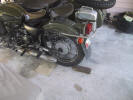
Place the bike on the center stand. An easier way on the
back or if you have a flat tire is to use a length of 2X4.
Set it behind the wheel... |
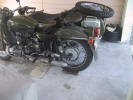
...roll the bike up on it... |
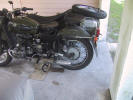
...then put the center stand down and finish pulling it up
by holding it with your foot and pulling up on the foot peg
and pillion grab handle. |
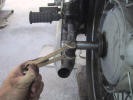
Use the 14mm and 17mm wrenches to loosen the axle pinch
bolt. Do not remove the bolt/nuts. |
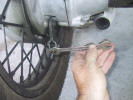
Back-off or remove the foot brake adjustment barrel. |
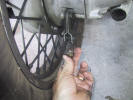
I remove it as I am eventually going to remove the final
drive later. |
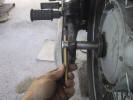
Take the tommy bar and turn the axle... |
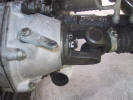
...so you can get to the cotter pin in the sidecar drive
stirrup. |
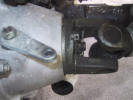
Use a pair of pliers to straighten the cotter pin arms. |
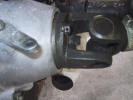
Use the tommy bar to turn the axle so you can get at the
head of the cotter pin... |
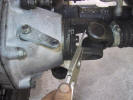
...and pull it out. |
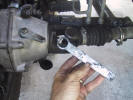
Next, take the URAL slogging wrench from you tool kit... |

...and place it on the castellated nut and hold it... |
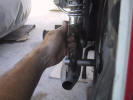
...while using the tommy bar to unscrew the axle. The axle
is right hand thread so lefty loosey, righty tighty. |

Nut removed. |
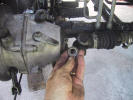
Behind the nut is a spacer washer, don't overlook it as it
usually remains stuck to the final drive and can disappear
later. |
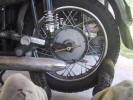
Leave the tommy bar in the axle, place both your feet
astride the wheel, grab the tommy bar with both hands and... |
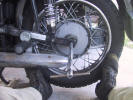
...pull it out. Sometimes it takes a little persuasion with
a hammer, especially when the rig is not yet worn in. |
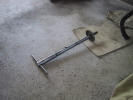
Place the dust cap on the axle and set it aside. |
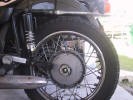
The tire can now be removed from the final drive and rolled
out from under the fender at a slight angle. Clean and
grease the axle and installation is in the reverse order. |